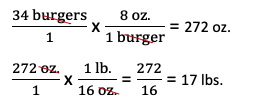
Culinary Math Teaching Series: Basics Unit Conversion
01 February 2023The Bridge Method offers students structured support when converting ounces, cups, tablespoons and more.
By Linda Blocker, CHE, Associate Professor at the State University of New York at Delhi
Feedback & comments: This email address is being protected from spambots. You need JavaScript enabled to view it.
Converting units of measure is at the core of many foodservice calculations. For my students, perfecting unit conversion goes hand-in-hand with strengthening basic math skills. Units of measure are calculated in fraction and decimal form. This is something many students struggle to understand. Even when they learn the correct way to calculate fractions and decimals, their thinking defaults to the errors that have haunted them since elementary school when solving a problem. Hopefully, the technique and tips I am offering you below will help break that cycle with your students so they are more successful with the culinary math topics covered in your classes and beyond.
Conversion basics: Why I choose to teach the Bridge Method
There are several approaches to converting units of measure. Teaching every approach is, in my opinion, confusing when students’ basic math skills are weak. Through the years of teaching culinary math concepts, I have concluded that teaching one method, not many, is the best course of action to support student learning. Offering several techniques can be confusing when learning new concepts, especially math concepts.
My method of choice is the Bridge Method. It is also called Dimensional Analysis or Stoichiometry (Chemistry). Whatever it is called, I have found it to be the most teachable method for converting units of measure for students who do not intuitively “see” what they need to do. I explain that it is like a type of conversion scaffolding that supports student thinking as they complete the calculations. This is not to say I do not support the other approaches some students choose. I confirm their approaches while I am teaching and will, from time to time, offer to have them share their approach.
Most students think they are doing something completely different from the Bridge Method, but usually, they are not. What they are doing is skipping the formality of it. I support that as long as their answers are correct most or all of the time. The structure of the Bridge Method truly helps students who are unsure of what to do until they successfully practice enough to become more confident and proficient.
Using the Bridge Method to Solve Conversion Problems
Here are the Bridge Method steps I teach:
- Start with the unit that needs to be converted. If it is a fraction, convert it to decimal. Put it over one.
- Put a multiplication sign next to it.
- To create the next fraction, start with filing in the units. The unit on the bottom should match the unit on the top of the first fraction. It is the unit being removed. The unit being converted should be on top.
- Once the units are in place, fill in the numbers for the equivalency.
- Multiply straight across, disregarding the units.
- Cancel the like units (diagonally) and carry over the remaining unit to the answer. If the answer is a fraction, reduce it.
Example 1: Convert 25 tablespoons to cups.
Solution with Bridge Method:

Example 2: Convert 42.5 grams to ounces
Solution with Bridge Method:

Example 3: Calculate the number of six fluid-ounce servings that can be poured from two and a half gallons of lemonade.
Solution with Bridge Method:

Example 4: Calculate the pounds of ground beef needed on Thursday for dinner if you project 34 eight-ounce burgers that evening that will be ordered.

There are other converting units of measurement methods. Many students can calculate the answer without using the Bridge Method. For the students who do struggle with what to do, the Bridge Method offers a structured approach that helps them to do the correct calculations and achieve the correct answer.
Next month, I will discuss advanced unit conversion between weight and volume measures.
